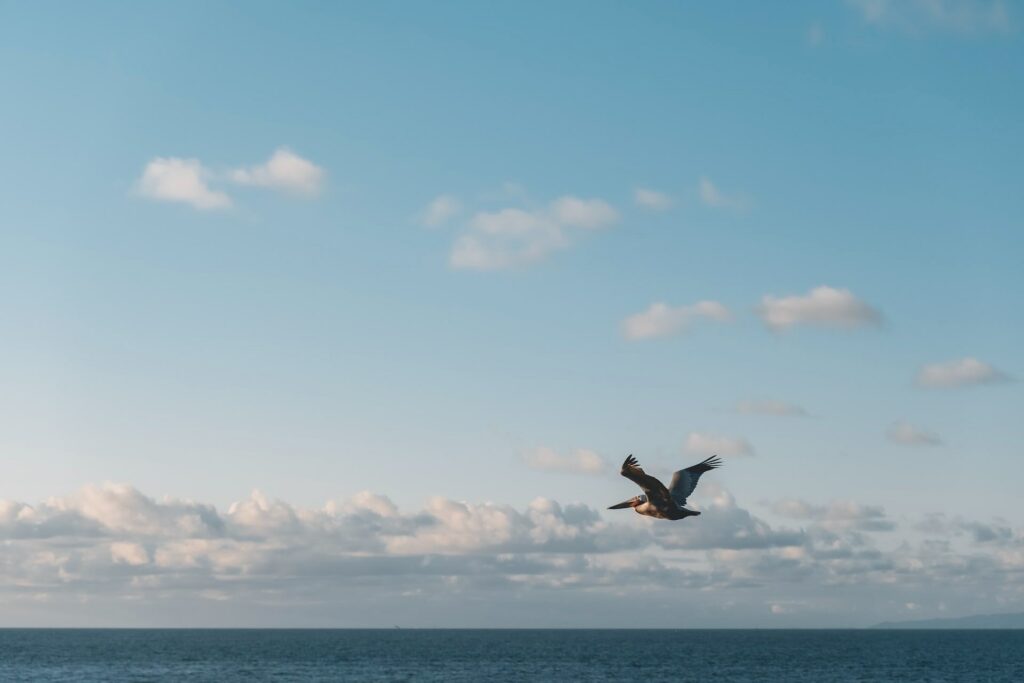You can see some amazing seabirds on our City Cruises Whale Watch cruise in San Diego, the most common of which can be found here. Here are some other, less common seabirds, including several species of herons, that can be found in San Diego Bay.
Reddish egret (Egretta rufescens)
The reddish egret is a fairly large heron with a gray body, a reddish neck, and bluish-black gray legs. Its bill is mostly pink and tipped with black. This active egret searches for food in shallow, saltwater habitats and often runs and hops to catch fish with its wings spread out. San Diego is near the northern part of the range for this species on the Pacific Coast.
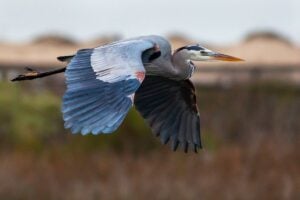
אנפה כחולה קטנה (Egretta caerulea))
האנפה הכחולה הקטנה היא אנפה קטנה עם גוף כחלחל-אפור כהה וראש וצוואר אדמדמים סגולים עד כהים. הצעירים הם ברובם לבנים עם נוצות כנף אפורות בהירות. כאשר צדים דגים וצפרדעים בבתי גידול של מים מתוקים רדודים או במים מלוחים, האנפה הכחולה הקטנה תעמוד דוממת במים רדודים ותמתין לטרף פוטנציאלי שישחה בקרבת מקום.
אנפה תלת-צבעונית (Egretta tricolor))
אנפה בינונית זו היא ברובה אפורה כהה עם בטן לבנה ונוצות אדמדמות על צווארה וגבה. לנער יש קו לבן זורם במורד גרונו. כשהוא מזדקן, הוא עומד ומחכה לדגים שישחו לידו, או הולך כדי לערבב את הקרקעית עם רגל כדי להבהיל את הטרף.
Green heron (Butorides virescens)
This small, beautifully-colored heron typically rests in a crouched position at the water’s edge often hidden within vegetation. It has a greenish back with a chestnut neck, face, and chest, white streaks on each cheek and throat, dark gray wings, a gray and yellow bill, and yellow legs. The green heron usually sits at the water’s edge and waits for fish and frogs to move by, then spears them with its dagger-like bill.
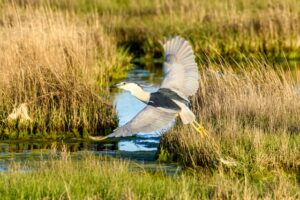
Black-crowned night heron (Nycticorax nycticorax)
The black-crowned night heron is fairly stocky with relatively short yellow legs. The plumage is dark gray from the top of its head to the back, with light-gray wing feathers, and white from the face to the belly. It also has a white patch extending from the base of the upper bill to above the red eyes. Juveniles are mottled brown and white. As its name implies, the black-crowned night heron feeds from dusk until dawn, searching for insects, worms, fishes, amphibians, and other small land and aquatic animals.
Brandt’s cormorant (Phalacrocorax penicillatus)
The Brandt’s cormorant is an iridescent black seabird found in saltwater habitats along the Pacific Coast of North America. Adults have a pale patch at the base of the throat, a bright blue throat pouch, and fine, white plume feathers on their head, neck, and back during the nesting season. During the non-breeding season, adults are much duller in color while juveniles are also a much duller brownish-black. Cormorants swim at the surface and then dive to catch fish or squid, using their webbed feet to actively swim after prey. Like other cormorants, the Brandt’s cormorant holds its wings out to dry after diving.
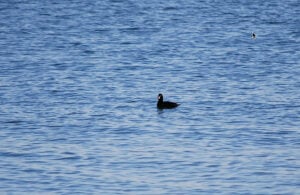
Surf scoter (Melanitta perspicillata)
This sea duck is strikingly patterned in black-and-white. The male is all black with a white forehead patch and a white patch on the back of his neck, and a white, orange, and black patterned bill. The female is a lighter brownish-black with white patches on each side of the head and at the base of the mostly dark gray bill. Nesting takes place during summer in freshwater lakes in high-elevation forests and the tundra mainly in Alaska and Canada. Surf scoters can be found in winter along both coasts of North America where it can often be seen diving for mollusks, crustaceans, and other aquatic invertebrates.
Pacific brant (Branta bernicla)
This small sea goose has a black head, neck, and chest with a broken white “collar” in the upper neck region, a brownish back, a black to light gray belly, and a white rump. The Brant nests in the Arctic on the tundra and spends winters feeding on eelgrass, sea lettuce, and other aquatic plants along both coasts of North America. The Pacific subspecies of brant winters from British Columbia to Baja California, Mexico, and can often be seen swimming and feeding in flocks during the late fall to early spring months in San Diego Bay.
Western grebe (Aechmophorus occidentalis)
The western grebe is a black and white grebe with a long neck, a spear-like yellow bill, and red eyes. This species has a black back with black extending along the back of its neck and a black cap that extends below the eyes. The almost identical Clark’s grebe can be distinguished from the western grebe by its white face (its black cap does not extend below the eyes). Western grebes nest on freshwater lakes and marshes and overwinter in bays, estuaries, and sheltered coasts. They dive to catch fish and occasionally crustaceans and aquatic worms. In the summer nesting grounds, adults perform an elaborate courtship display by rushing across the water with their necks extended.
Pied-billed grebe (Podilymbus podiceps)
The pied-billed grebe is a small, stocky, brown, bird with a short wedge-shaped bill, a brown body, and an extremely short tail. Their bill is marked with a vertical black stripe in the summer giving rise to their common name. Pied-billed grebes dive to hunt small fishes, crustaceans, insects, amphibians, and other small aquatic animals in freshwater lakes, rivers, marshes, and saltwater estuaries and bays.
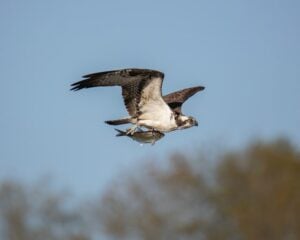
Osprey (Pandion haliaetus)
The Osprey is a common fish-eating hawk spotted in freshwater and saltwater habitats worldwide except in Antarctica. These attractive birds of prey are black to brown and white and have hooked bills and yellow eyes. They have a reversible outer toe on each foot and barbed pads on the soles that let them catch and easily grasp slippery fish. Osprey pairs build huge nests of sticks and other vegetation that are added to each nesting season and used from year to year. Often these nests are built on sea stacks, dried tree snags, and even man-made structures such as light towers, utility poles, and artificial platforms. Some of these nests are decades old and can be 10 to 13 feet tall and 3 to 6 feet across.
שקנאי חום (Pelecanus occidentalis)
השקנאי החום הוא השקנאי הגדול ביותר בצפון אמריקה. לציפורים הגדולות האלה יש מראה אופייני, צוואר ארוך ושטרות גדולים עם נרתיק גרון המשמש ללכידת דגים. צבעם של השקנאים הוא ברובו חום כהה עם מעט חום-אפרפר בהיר יותר על כנפיהם וצווארם. ניתן למצוא אותם באזורי חוף ברחבי רוב צפון אמריקה, שם הם ניזונים כמעט אך ורק מדגים קטנים שהם לוכדים על ידי צלילה מהאוויר למים. הרבייה מתרחשת לאורך חופים מווירג'יניה ועד טקסס וקליפורניה ובפנים הארץ לאורך האגמים הגדולים.
שקנאי לבן אמריקאי (Pelecanus erythrorhynchos)
The American white pelican is one of the largest North American birds, with a wingspan reaching almost 10 feet. They are all white with black wingtips and have a long bill with a large throat pouch used for scooping up fish. Pelicans feed cooperatively, swimming in groups to herd and trap small fishes in shallow water where they can be easily caught. These big birds breed along inland lakes in western Canada and the northern United States and spend winters along coasts from California to Texas.
קורמורן פלגי (פלקרוקורקס פלגיקוס)
קורמורן פלגי (שם מדעי: Pelagic cormorant) הוא מין של קורמורן המתרבה באזורי אוקיינוס פתוח ברחבי העולם. ציפור זו שחורה לחלוטין, עם שטר ארוך ומכורבל וכפות רגליים מרושתות. הקורמורן הפלגי הוא שחיין מצוין ויכול לצלול לעומקים של מעל 50 מטרים בחיפוש אחר דגים. ציפורים אלה מקננות בדרך כלל על פני צוקים או על עצים ליד גופי מים. הקורמורן הפלגי הוא יצור חברתי ולעתים קרובות יוצר מושבות גדולות עם ציפורים אחרות. עם זאת, מין זה אינו חף מטורפיו; שחפים, נשרים ועופות דורסים אחרים תוקפים לעתים קרובות קורמורנים פלגיים.

קורמורן דו-פסיגי (Phalacrocorax auritus)
הקורמורן בעל הפסים הכפולים הוא עוף מים גדול בעל צוואר ארוך ושטר קרס. הוא מצוי בבתי גידול של מים מתוקים ומים מלוחים ברחבי רוב צפון אמריקה. הקורמורן בעל הפסים הכפולים הוא שחיין וצוללן מצוין וניזון מדגים, סרטנים וחיות ימיות אחרות. נוצותיה הכהות של הציפור מסייעות להסוות אותה מפני טורפים, וכפות רגליה המרושתות מסייעות לה לחתור במהירות במים. הקורמורן בעל הפסים הכפולים הוא מין מוגן, ומספריו גדלו בשנים האחרונות. עם זאת, ההרגל של הציפור לקנן על מבנים מעשה ידי אדם, כגון קווי חשמל וסירות גרם לעימות מסוים עם בני אדם.
יונת סלע (קולומבה ליוויה)
יונת הסלע היא מין של יונה שמקורה באירופה, אסיה ואפריקה. היא גם הציפור הנפוצה ביותר בערים. יונת הסלע היא ציפור בגודל בינוני עם גוף שמנמן ורגליים קצרות. נוצותיו בדרך כלל אפורות או כחולות אך יכולות להיות גם לבנות, חומות או שחורות. לציפור יש ראש קטן עם מקור מחודד. יוני סלע חיות בדרך כלל בלהקות ולעתים קרובות נראות מחפשות מזון באזורים עירוניים. הם ידועים גם בקולות הקוליים שלהם. יונת הסלע היא מין חשוב הן בטבע והן בשבי. הוא משמש לעתים קרובות במחקר בשל יכולתו להסתגל לסביבות שונות. יונת הסלע הוכנסה גם לחלקים רבים בעולם, שם התבססה כמין מטרד.
מסקנה
אם אתה רוצה לראות כמה מציפורי הים הפחות נפוצות במפרץ סן דייגו, הקפד לבדוק את הרשימה שלנו. בעוד שניתן לראות כאן מינים רבים נוספים, אנו חושבים שחמישה עשר אלה יתנו לכם דגימה טובה של מה שיש שם בחוץ. האם הבחנתם באחת מהציפורים האלה בטיולים שלכם ברחבי המפרץ? ספרו לנו בתגובות למטה!


